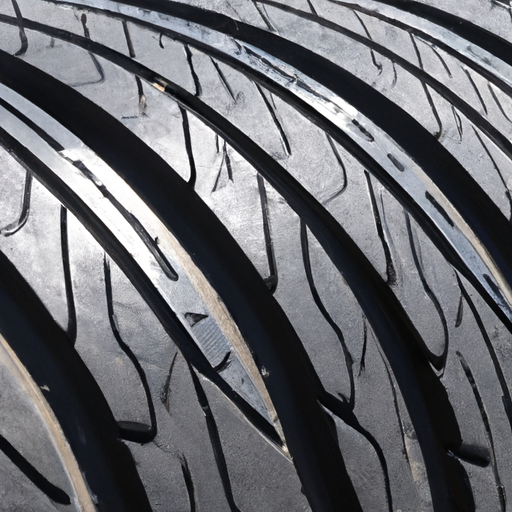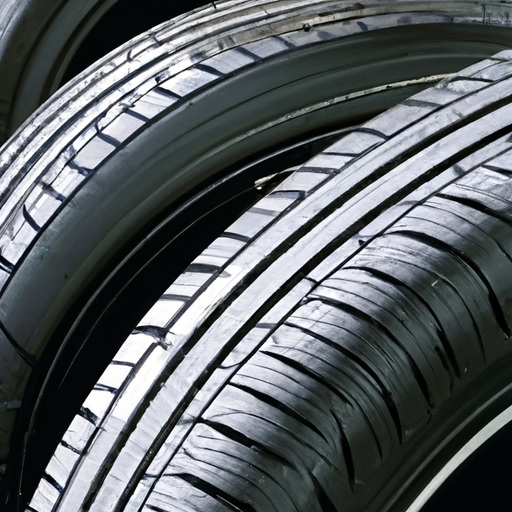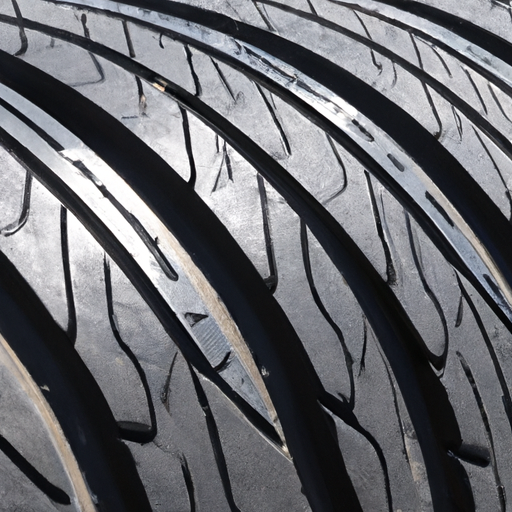If you’re in the market for high-performance summer tires, you may be wondering if there are specific tread patterns designed to enhance their performance. Well, you’re in luck! In this article, we’ll explore the world of high-performance summer tires and delve into the importance of tread patterns in maximizing their capabilities. So, buckle up and get ready to learn about the tire technology that can take your driving experience to the next level.
Tread Pattern Characteristics
When it comes to tires, the tread pattern is an important factor to consider. Tread patterns are the design elements on the surface of the tire that come into contact with the road. These patterns are not just for aesthetics; they serve various purposes, including enhancing traction, improving handling, dissipating heat, reducing noise, and increasing tire longevity.
Tread Depth
Tread depth refers to the vertical measurement from the top of the tread to the bottom of the tire’s deepest grooves. It is a critical characteristic that affects tire performance. In general, deeper tread depths offer better traction and can effectively channel water away from the tire’s contact patch, reducing the risk of hydroplaning. However, in dry conditions, a shallower tread depth can provide a larger contact area, maximizing grip and improving handling.
Tread Blocks
Tread blocks are the individual blocks or ribs on the tire’s surface. Their configuration and size can significantly impact tire performance. When it comes to high-performance summer tires, tread blocks with high stiffness are desirable. These rigid blocks provide enhanced stability and increased responsiveness during cornering and handling. Larger shoulder blocks are often incorporated into the tread pattern to provide additional stability when taking tight turns at higher speeds.
Groove Patterns
Grooves are the longitudinal channels or channels on the tire surface. They help to channel water away from the tire’s contact patch, reducing the risk of hydroplaning and improving wet performance. For high-performance summer tires, wide circumferential grooves are commonly utilized. These grooves efficiently evacuate water from the center of the tire, maintaining maximum grip even in wet conditions. V-shaped grooves also play a vital role in enhancing wet performance by further assisting with water evacuation.
Siping
Sipes are tiny slits or thin grooves cut into the tire’s tread blocks. They help to improve traction by creating additional biting edges when the tire comes into contact with the road. Multi-directional sipes are often found on high-performance summer tires to enhance traction and braking in various conditions. These sipes allow the tread blocks to flex and adapt to the road surface, providing better grip on both dry and wet roads.
Shoulder Design
The shoulder of a tire refers to the outer edge of the tread area. The design of the shoulder can substantially impact cornering and handling performance. In high-performance summer tires, large shoulder blocks are often incorporated to provide increased rigidity and stability during aggressive maneuvering. This design choice allows for better control, responsiveness, and confidence when taking turns at higher speeds.
Tread Patterns for Dry Performance
When it comes to dry performance, certain tread patterns excel in providing optimal grip and handling. Here are three popular tread patterns used in high-performance summer tires:
Continuous Center Rib
A continuous center rib tread pattern features a solid rib that runs continuously down the center of the tire. This design provides a larger contact area and maximizes stability during high-speed driving. The continuous rib enhances straight-line acceleration, braking, and overall responsiveness, making it an excellent choice for dry performance.
Directional Tread
A directional tread pattern features V-shaped grooves that point in a specific direction, typically towards the front of the vehicle. This pattern enhances water evacuation and reduces the risk of hydroplaning in wet conditions. However, on dry surfaces, the directional tread pattern provides exceptional cornering and handling capabilities. The V-shaped grooves create additional biting edges, increasing traction and grip, especially during aggressive maneuvers.
Asymmetric Tread
An asymmetric tread pattern combines different elements on the inner and outer parts of the tire’s surface. This pattern allows for a balance between dry and wet performance. On the dry side, an asymmetric tread pattern often features larger tread blocks and solid ribs, providing stability and increased responsiveness during cornering and handling. This design choice ensures that high-performance summer tires deliver exceptional performance on both dry and wet roads.

Tread Patterns for Wet Performance
Wet performance is a crucial consideration when it comes to selecting high-performance summer tires. Here are three tread patterns specifically designed to enhance performance in wet conditions:
Wide Circumferential Grooves
Wide circumferential grooves are commonly found in tread patterns for high-performance summer tires. These grooves efficiently channel water away from the tire’s contact patch, minimizing the risk of hydroplaning and ensuring maximum grip on wet surfaces. The wider the grooves, the better the water evacuation, resulting in improved wet performance.
V-Shaped Grooves
V-shaped grooves are another feature commonly seen in tread patterns for wet performance. These grooves provide additional water evacuation channels, allowing the tire to maintain contact with the road surface even in heavy rain. The V-shaped design aids in dispersing water quickly and efficiently, enhancing traction and reducing the risk of hydroplaning.
Silica Compound
While not directly related to the tread pattern, the compound used in high-performance summer tires contributes significantly to wet performance. Tires with a silica compound offer improved grip on wet roads by enhancing traction and reducing braking distances. The silica compound helps the tire maintain flexibility and grip in lower temperatures, ensuring optimal wet performance even in challenging conditions.
Tread Patterns for Cornering and Handling
When it comes to cornering and handling, specific tread patterns are designed to provide maximum grip and stability. Here are some tread pattern characteristics that enhance cornering and handling performance:
Tread Blocks with High Stiffness
Tread blocks with high stiffness play a crucial role in enhancing cornering and handling capabilities. These rigid blocks ensure that the tire maintains its shape and stability during aggressive maneuvers, providing consistent grip and improving overall responsiveness. The high stiffness allows the tire to effectively transmit steering inputs, giving the driver better control and confidence while navigating corners at higher speeds.
Large Shoulder Blocks
Large shoulder blocks contribute to improved cornering and handling performance. These blocks increase the contact area with the road during turning, providing enhanced stability and grip. The larger the shoulder blocks, the better the tire’s ability to withstand lateral forces, reducing the risk of slipping or skidding during cornering. This design choice enhances the tire’s overall performance and inspires confidence in the driver.
Solid Center Rib with Grooves
A solid center rib with grooves is a tread pattern characteristic that aids in cornering and handling. The solid center rib provides stability and precise steering response during straight-line driving, ensuring accuracy and control. The addition of grooves on the center rib creates flexibility and grip on the road surface during cornering, improving traction and enhancing overall cornering performance.
Variable Pitch Technology
Variable pitch technology is a tread pattern feature that enhances cornering and handling performance by reducing noise and improving stability. This technology involves varying the size and spacing of the tread block pitches. By doing so, it reduces the noise generated by the tire while maintaining stability and control during cornering. The optimized pitch sequences also contribute to better water evacuation, ensuring consistent grip in wet conditions.

Tread Patterns for Traction and Braking
Traction and braking are critical aspects of tire performance, especially in high-performance summer tires. Here are some tread pattern characteristics that enhance traction and braking capabilities:
Multi-Directional Sipes
Multi-directional sipes are small slits or grooves cut into the tread blocks in various directions. These sipes help provide superior traction on different road surfaces by creating additional biting edges. Multi-directional sipes allow the tire’s tread blocks to flex and adapt to the road, enhancing grip and traction during acceleration, braking, and cornering. The increased contact with the road improves overall traction and reduces the stopping distance.
Zigzag Grooves
Zigzag grooves are an effective tread pattern characteristic that enhances traction and braking. The zigzag design creates additional edges that bite into the road surface, increasing grip and traction during acceleration and braking maneuvers. These grooves also aid in water evacuation, reducing the risk of hydroplaning and maintaining traction in wet conditions. Zigzag grooves provide the necessary grip and performance required in high-performance summer tires.
Water Evacuation Channels
Water evacuation channels are features commonly found in tread patterns for high-performance summer tires. These channels efficiently disperse water from the tire’s contact patch, reducing the risk of hydroplaning and maintaining traction on wet roads. The design and placement of these channels vary, but their primary purpose is to enhance wet performance by minimizing the water’s presence between the tire and the road surface.
High Void Ratio
The void ratio refers to the ratio of the open space between the tread blocks to the total tread area. A high void ratio means there is a larger open space between the tread blocks. This characteristic aids in water evacuation, enhancing wet traction and reducing the risk of hydroplaning. A high void ratio allows the tire to effectively channel and expel water from the contact patch, ensuring optimal traction and grip on wet surfaces.
Tread Patterns for Noise Reduction
Noise reduction is an essential aspect of tire design, and specific tread patterns are engineered to minimize noise levels. Here are some tread pattern characteristics that contribute to noise reduction:
Variable Block Sizes
Variable block sizes are a feature found in tread patterns designed for noise reduction. By varying the size of the tread blocks, tire manufacturers can reduce the noise generated during rotation. The differing block sizes disrupt the sound waves and reduce the overall noise level, providing a quieter and more comfortable driving experience.
Silent Groove Design
Silent groove design is another characteristic employed in tread patterns dedicated to noise reduction. These grooves are strategically placed within the tread pattern to disrupt the airflow and reduce noise caused by tire rotation. The specific placement and geometry of these grooves help to minimize noise levels, resulting in a quieter ride.
Optimized Pitch Sequences
Optimized pitch sequences play a vital role in reducing tire noise. By carefully arranging and varying the pitch sequences of the tread blocks, manufacturers can minimize the generation of specific noise frequencies. These optimized pitch sequences help create a harmonious and quieter sound pattern, resulting in a more enjoyable driving experience.

Tread Patterns for Heat Dissipation
Heat dissipation is a critical factor to consider for high-performance summer tires, as excessive heat buildup can negatively affect tire performance and longevity. Here are some tread pattern characteristics that aid in heat dissipation:
Groove Structure with Wide Ribs
A groove structure with wide ribs is commonly found in tread patterns designed for heat dissipation. The wide ribs allow for increased contact with the road, facilitating heat transfer from the tire to the road surface. Additionally, the groove structure helps to channel air and dissipate heat away from the tire, preventing overheating and ensuring optimal performance.
Cooling Fins
Cooling fins are specific features incorporated into the tread pattern to assist in heat dissipation. These fins act as additional cooling channels, promoting airflow around the tire. The increased airflow aids in dissipating heat, preventing excessive temperature buildup, and maintaining optimal tire performance. Cooling fins contribute to a longer tire life and reduced risk of tire failure.
Silent Rib Technology
Silent rib technology is utilized in tread patterns to both reduce noise levels and facilitate heat dissipation. The ribs in the tread pattern are designed to promote efficient heat transfer, allowing heat to dissipate evenly across the tire’s surface. By incorporating this technology, tire manufacturers can ensure that high-performance summer tires maintain their integrity even under extreme conditions, prolonging their lifespan.
Tread Patterns for Longevity
Longevity is an important consideration when investing in high-performance summer tires. Here are some tread pattern characteristics that contribute to tire longevity:
Hard Compound Construction
Tire longevity is often achieved through the use of a hard compound construction. High-performance summer tires with a hard compound are designed to resist wear and abrasion, resulting in extended tread life. The harder compound offers increased durability, making these tires suitable for high-performance driving without sacrificing longevity.
Reinforced Tread Blocks
Reinforced tread blocks are a common feature found in tread patterns designed for longevity. These reinforced blocks are engineered to withstand the high forces and stresses generated during aggressive driving. By reinforcing the tread blocks, tire manufacturers enhance the tire’s resistance to wear and deformation, ensuring a longer lifespan without compromising performance.
Optimized Contact Patch
An optimized contact patch refers to the area of the tire that comes into contact with the road surface. Tread patterns designed for longevity often incorporate an optimized contact patch to distribute the forces evenly, reducing stress and wear on specific areas of the tire. By optimizing the contact patch, tire manufacturers can enhance tire longevity and ensure consistent performance throughout the tire’s lifespan.

Tread Patterns for Performance on Different Surfaces
High-performance summer tires are often designed to perform exceptionally well on various surfaces. Here are some tread patterns tailored for specific performance requirements:
Tread Patterns for Dry and Wet Performance
Some tread patterns are engineered to deliver superior performance on both dry and wet surfaces. These tread patterns often feature a combination of characteristics such as directional tread, large shoulder blocks, and wide circumferential grooves. By incorporating features that cater to both dry and wet performance, these tread patterns provide balanced performance in various driving conditions.
Tread Patterns for All-Season Performance
While high-performance summer tires are primarily designed for warm weather conditions, some models are engineered for all-season performance. These tread patterns incorporate a combination of characteristics to ensure grip and traction in a variety of weather conditions, including dry, wet, and light snow. The design often includes multi-directional sipes, siping, and adaptive compounds to enhance the tire’s all-season capabilities.
Tread Patterns for Track Use
For those seeking optimal performance on racetracks or during spirited driving, specific tread patterns cater to track use. These patterns prioritize dry performance and cornering capabilities, often incorporating large tread blocks, solid center ribs, and stiff sidewalls. The design is focused on maximizing grip, stability, and responsiveness, giving drivers the confidence to push their high-performance summer tires to the limit on the track.
Conclusion
In conclusion, there are indeed specific tread patterns designed for high-performance summer tires. These tread patterns feature various characteristics tailored to specific performance requirements, such as dry performance, wet performance, cornering and handling, traction and braking, noise reduction, heat dissipation, longevity, and performance on different surfaces. By understanding the different tread pattern characteristics and how they impact tire performance, you can make an informed decision when choosing high-performance summer tires that meet your specific driving needs. Remember to consider the driving conditions you will encounter, your vehicle’s capabilities, and your personal preferences to find the perfect tread pattern for optimal performance and enjoyment on the road.


